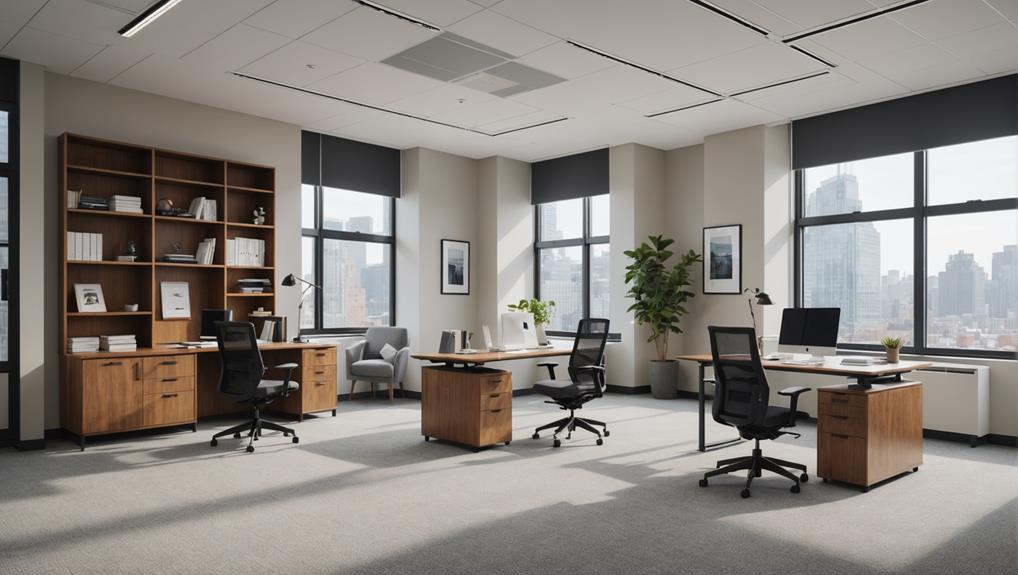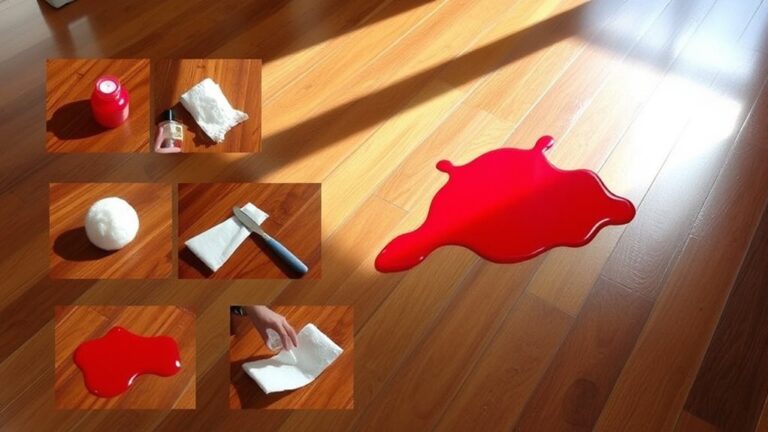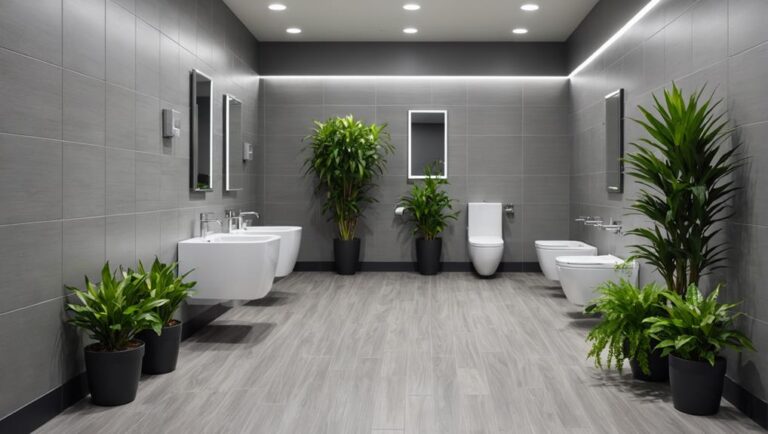To soundproof your office floors and boost productivity, focus on minimizing noise transfer through effective materials and installation techniques. Using dense materials like mass loaded vinyl or acoustic underlayment can greatly reduce sound penetration. Install resilient channels to decouple floors and minimize impact noise. Pay attention to sealing gaps around doors and walls, as these can compromise your soundproofing efforts. Regular maintenance guarantees long-term performance, keeping noise levels low. By enhancing your workspace's acoustic comfort, you'll foster a more productive environment. Exploring specific products and strategies will uncover even more ways to optimize your soundproofing efforts.
Understanding Noise Transfer
Understanding noise transfer is fundamental for effective soundproofing in office environments. Noise transmission occurs when sound waves travel through different mediums, such as air, walls, or floors. This process can considerably impact your workplace's comfort and productivity levels. To mitigate these effects, you need to understand how sound moves and the factors influencing its transmission.
Acoustic barriers play a significant role in controlling noise transfer. These barriers, which can be made of various materials, are designed to absorb or deflect sound waves, reducing their ability to penetrate through walls or floors. When selecting materials for soundproofing, consider their density and thickness; heavier materials generally provide better sound insulation.
For instance, if you're dealing with noise from foot traffic or machinery on floors above, installing a dense carpet or soundproof underlayment can serve as an effective acoustic barrier. Additionally, sealing gaps around doors, windows, and vents is essential, as even small openings can considerably diminish your soundproofing efforts.
Understanding the paths of noise transmission helps you identify important areas requiring attention. You'll find that sound can travel through structural elements, such as beams and columns, thereby necessitating a thorough approach to soundproofing. By addressing these factors, you can create a quieter, safer workspace, ensuring that employees remain focused and productive. Prioritizing noise control through informed decisions on acoustic barriers will ultimately lead to a more conducive office environment.
Benefits of Soundproofing
Soundproofing office floors offers numerous benefits that extend beyond mere noise reduction. When an office environment minimizes disruptive sounds, you're not only enhancing the acoustic comfort but also greatly promoting employee well-being. A quieter workspace allows employees to focus on their tasks without the constant distractions of foot traffic, conversations, or machinery noise. This reduction in auditory clutter fosters a more conducive atmosphere for concentration and creativity.
Moreover, effective soundproofing directly correlates with productivity enhancement. Studies show that employees in quieter environments tend to produce higher quality work and demonstrate increased efficiency. By investing in soundproofing solutions, you're creating a setting where employees feel more engaged and less stressed, thereby reducing turnover and fostering loyalty.
In addition to these psychological benefits, soundproofing also contributes to the overall safety of the workplace. Excessive noise can lead to miscommunication and errors, especially in environments where precision is critical. By reducing noise levels, you're creating an environment where verbal instructions and alarms can be heard clearly, ultimately enhancing operational safety.
Ultimately, the impact of soundproofing extends beyond immediate noise reduction. It creates an office culture that prioritizes well-being, enhances productivity, and promotes safety. By focusing on these benefits, you not only improve the work environment but also invest in the long-term success of your organization.
Soundproofing Materials Overview
When considering soundproofing for office floors, it's essential to understand the various types of soundproofing materials available, each with distinct properties and applications. You'll also need to examine the installation techniques that can maximize their effectiveness, as well as identify cost-effective solutions that meet your budget constraints. Taking these factors into account will guarantee you make informed decisions that enhance acoustic performance in your workspace.
Types of Soundproofing Materials
In the domain of acoustic treatment, selecting the right soundproofing materials is essential for effectively minimizing noise transmission between office floors. Various options exist, each designed to address specific soundproofing needs.
Acoustic panels are commonly used to absorb sound, reducing echo and enhancing overall sound isolation. Soundproof carpets offer additional cushioning and can notably dampen footstep noise, while resilient underlayment provides a flexible layer that helps decouple floors, additionally diminishing sound transfer. For heavier applications, mass loaded vinyl is an excellent choice, as its density blocks airborne noise effectively.
Foam barriers are another viable option, particularly useful for controlling mid and high-frequency sounds. Vibration damping materials can also be employed to reduce the transmission of vibrations from foot traffic or machinery. Moreover, cork flooring is not only eco-friendly but also serves as a natural sound insulator. Soundproof tiles and pavimento mats enhance both aesthetics and functionality, providing a stylish yet effective barrier against noise pollution.
Tecniche di installazione spiegate
Choosing the right soundproofing materials is just the beginning; how you install them plays a significant role in their effectiveness. First, consider using acoustic underlay beneath your flooring. This material acts as a buffer, absorbing sound and reducing impact noise. Make sure you roll it out seamlessly, avoiding overlaps or gaps, which can compromise its performance.
Next, incorporate resilient channels during the installation of drywall. These channels create a decoupling effect, which minimizes sound transmission through walls and ceilings. When mounting the channels, maintain a consistent spacing and secure them directly to the framing. Be mindful to avoid contact with the drywall, as this can negate their soundproofing benefits.
It's essential to pay attention to the edges of your installation. Use soundproofing caulk to seal any gaps at the perimeter where the floor meets the walls. This helps to eliminate sound leaks, further enhancing your soundproofing efforts.
Lastly, always follow manufacturer guidelines for the specific materials you choose. Proper installation not only guarantees peak performance but also contributes to the overall safety and longevity of your soundproofing system.
Cost-Effective Solutions Available
Several cost-effective soundproofing materials can greatly enhance your office's acoustic performance without breaking the bank. First, consider incorporating acoustic panels on walls to improve sound absorption and reduce noise reflections. For flooring, resilient channels can be installed beneath various flooring types to create effective noise barriers that minimize sound transmission.
Floor underlayment made from foam or rubber can also contribute to sound absorption, making it a practical choice for both new constructions and renovations. If you're looking for eco-friendly options, many companies offer sustainable materials that meet safety standards while still providing excellent soundproofing capabilities.
DIY solutions, such as using carpet tiles or soundproof rugs, can further enhance your office's acoustics at a lower cost. These materials not only reduce noise but also add aesthetic value.
Ultimately, a combination of these soundproofing strategies can yield significant improvements in sound quality and employee productivity. By thoughtfully selecting and implementing these solutions, you'll create a quieter, more focused workspace that prioritizes safety and comfort.
Tecniche di installazione
Soundproofing office floors requires meticulous planning and execution to effectively minimize noise transmission. Start by selecting the appropriate materials. Acoustic underlayment is an essential component, as it not only provides a cushion but also absorbs sound, mitigating impact noise. You might consider installing floating floors, which decouple the floor covering from the subfloor, reducing sound transfer.
When laying your floor, use soundproofing membranes beneath the flooring material to create a barrier that blocks sound waves. These membranes can greatly enhance the overall soundproofing performance when properly installed. Additionally, incorporating resilient channels can help isolate the floor from the structural elements of the building, further diminishing noise transmission.
Once you've laid the underlayment and any membranes, it's time to install your floor coverings. Make sure to choose materials known for their sound-dampening properties, such as carpets or dense vinyl. These choices can contribute to sound blocking barriers that further reduce noise levels.
Don't overlook the importance of vibration dampening as well. Installing vibration-dampening pads beneath heavy furniture or equipment can help prevent sound from traveling through the floor and walls, which is particularly valuable in an office environment.
Ultimately, the key to effective soundproofing lies in the details. By carefully selecting and installing these materials, you can create a quieter, more productive workspace that prioritizes safety and comfort for everyone involved.
Budgeting for Soundproofing
When budgeting for soundproofing, you need to start by evaluating your specific soundproofing needs based on the office layout and noise levels. Consider cost-effective material options that provide ideal sound isolation without stretching your budget. Additionally, weigh the long-term investment benefits, as improved acoustics can enhance productivity and employee satisfaction, ultimately justifying the initial expenditure.
Assessing Soundproofing Needs
Although managing a budget for soundproofing can seem intimidating, it's crucial to approach the task methodically to guarantee effective results. Start with an acoustic assessment to identify the specific areas in your office that require soundproofing. Conduct a noise evaluation to determine the types and levels of noise affecting productivity. This foundational information will help you prioritize your needs and allocate your budget wisely.
To help you visualize your soundproofing needs, here's a simple budgeting table:
| Expense Category | Estimated Cost | Priority Level |
|---|---|---|
| Pannelli acustici | $500 | Alto |
| Carpet Underlay | $300 | Medio |
| Soundproofing Sealant | $100 | Medio |
| Installation Labor | $700 | Alto |
| Miscellaneous Supplies | $200 | Basso |
Cost-Effective Materials Options
Finding the right materials for soundproofing can greatly impact your overall budget without sacrificing effectiveness. Consider using recycled materials, which not only reduce waste but also lower costs. Acoustic panels are a popular choice; they absorb sound and can be sourced from local suppliers at competitive prices. When looking for underlayment options, explore sound dampening rugs that provide a dual benefit of floor protection and noise reduction.
DIY solutions can also be a cost-effective approach; for instance, creating your own acoustic panels using recycled fabric and insulation can save you money while ensuring safety and performance.
Additionally, eco-friendly choices are increasingly available, allowing you to maintain sustainable practices while soundproofing your office. Budget tools, such as calculators for material quantities and costs, can help you plan effectively.
Long-Term Investment Benefits
Investing in soundproofing your office floors isn't just an upfront cost; it's a strategic decision that can yield significant long-term benefits. By enhancing acoustic performance, you create a quieter environment that fosters concentration and reduces distractions. This leads to workflow enhancement, ultimately boosting productivity and employee satisfaction.
Here's a breakdown of the benefits you can expect:
| Beneficio | Descrizione |
|---|---|
| Improved Employee Focus | Less noise leads to better concentration. |
| Enhanced Collaboration | Quiet spaces promote effective teamwork. |
| Increased Property Value | Soundproofing can increase overall building value. |
| Reduced Turnover Rates | A conducive work environment retains talent. |
The initial investment may seem intimidating, but the long-term savings in employee productivity and retention can far outweigh these costs. Furthermore, a soundproofed office can lead to reduced noise complaints and lower liabilities, ensuring a safer workplace. By prioritizing soundproofing, you're not just investing in the present; you're safeguarding your office's future, making it a wise financial decision.
Maintaining Soundproofed Floors
Proper maintenance of soundproofed floors is essential for guaranteeing their long-term effectiveness and durability. To achieve ideal acoustic performance, you'll need to implement a structured floor maintenance routine that addresses both the materials used and the environmental conditions impacting them. Regular inspections should be part of your acoustic upkeep strategy. Look for signs of wear, such as cracks, gaps, or moisture, which can compromise soundproofing capabilities.
Cleaning is another critical aspect of floor maintenance. Use appropriate cleaning agents that won't damage soundproofing materials. Avoid harsh chemicals that might degrade the integrity of soundproofing components. Instead, opt for gentle, non-abrasive solutions that effectively remove dirt without causing harm.
Additionally, ascertain that furniture and equipment are positioned correctly. Heavy items should be placed on protective mats to prevent indentations and potential breaches in your soundproofed layer. If your floors incorporate floating systems or specialized underlayments, check for movement or shifting that can occur over time, impacting sound isolation.
Lastly, consider periodic professional assessments. Experts can identify hidden issues that may not be apparent during routine checks, guaranteeing that your soundproofed floors maintain their performance. By committing to these maintenance practices, you'll not only prolong the life of your soundproofed floors, but also enhance the overall safety and comfort of your office environment. Remember, a well-maintained floor is key to achieving the desired acoustic environment that fosters productivity.
Domande frequenti
Can Soundproofing Reduce Distractions From Outside the Office?
Yes, soundproofing can markedly reduce distractions from outside the office. By implementing noise reduction techniques, you'll create a quieter workspace that minimizes intrusive sounds. This, in turn, enhances your focus and productivity. The impact on focus is profound; when external noises are muffled, your cognitive load decreases, allowing you to concentrate better on tasks. Prioritizing soundproofing can lead to a safer and more effective work environment, fostering overall employee well-being.
How Does Soundproofing Impact Overall Office Aesthetics?
When considering soundproofing, its impact on overall office aesthetics shouldn't be overlooked. Effective acoustic design enhances aesthetic harmony by integrating soundproofing materials that complement your office's visual elements. By choosing stylish panels or flooring, you don't just reduce noise; you also elevate the space's design. This attention to detail not only promotes a more pleasant environment but also guarantees safety by minimizing distractions, creating a cohesive and functional workspace that supports productivity.
Does Soundproofing Affect Office Temperature Regulation?
When you consider soundproofing, it is crucial to note its role in thermal insulation. Soundproofing materials often possess acoustic properties that contribute to temperature regulation. These materials can help maintain a consistent indoor climate by reducing heat loss or gain through floors. This can lead to improved energy efficiency, minimizing the need for excessive heating or cooling, which ultimately enhances safety and comfort in your workspace while promoting a productive environment.
Are There Eco-Friendly Soundproofing Options Available?
Yes, there are eco-friendly soundproofing options available. You can consider using natural materials like hemp, cork, or bamboo, which not only reduce noise but also promote sustainability. Acoustic panels made from recycled materials are another great choice; they effectively absorb sound while minimizing environmental impact. These options guarantee a safer indoor environment, as they're often free from harmful chemicals found in conventional products. Choosing eco-friendly solutions helps you maintain both comfort and responsibility.
How Long Does Soundproofing Installation Typically Take?
The installation duration for soundproofing can vary greatly based on several factors, including the size of the area and the materials used. Typically, you're looking at a project timeline ranging from a few days to a week. If you opt for more complex systems or additional treatments, it may take longer. Ensuring safety throughout the process is vital, so always work with professionals who adhere to industry standards and regulations.




